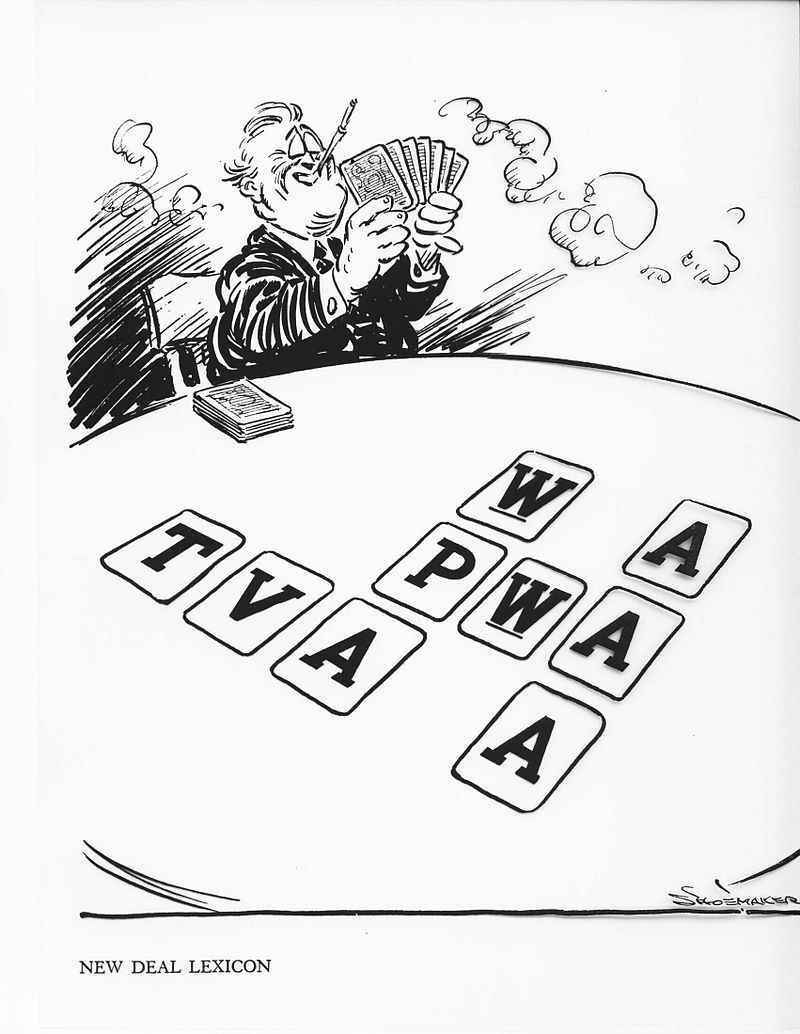
The "New Deal" and The Three R's
President Franklin D. Roosevelt (FDR) was elected president in 1932 and created a "New Deal" in his first 100 days of office. The "New Deal" was organized to help America recover from the depression. The "New Deal" consisted of the 3 R's which are Relief, Recovery, and Reform.
Relief was aimed at providing temporary help to suffering and unemployed Americans.
-Examples:
1. CCC & WPA: FDR set up the Civilian Conservation Corps (CCC) and the Works Progress Administration (WPA) to provide jobs to millions of unemployed Americans and "stimulate" the economy. The WPA and CCC built more than 650,000 miles of roads as well as 150,000 schools, airports, hospitals, parks, dams, and other public projects, many of which are still in use today.
2.Social Security Act: A law enacted in 1935 to provide aid and financial security to retirees, the unemployed, people with disabilities, and dependent mothers with children. During the depression, approximately 50% of senior citizens lived in poverty. Like many Americans appalled at the sight of fellow citizens living their final years in poverty after a lifetime of hard work, FDR believed that a nation as prosperous and advanced as the U.S. should not allow retired citizens to suffer poverty. It protects citizens from poverty during retirement, and provides temporary relief for involuntary unemployed Americans and families seeking new jobs- a program known as Unemployment Insurance. The funds for Social Security are collected from every paycheck-worker and employers split the tax contributions that the government collects. After age 62, citizen's receive a monthly pension check back from the government.
Recovery was designed to help the economy bounce back from depression.
-Examples:
1. Agricultural Adjustment Act: Several measures were introduced to arrest the fall in agricultural prices that had been causing hardship in the country's farming industry. The first Agricultural Adjustment Act, which was passed on May 12, 1933, created the Agricultural Adjustment Administration. This agency negotiated restrictions on the production of corn, cotton, dairy products, hogs, rice, tobacco, and wheat, and compensated farmers for the crops and livestock that they did not produce from funds raised by a tax on food processing. Since the law went into effect after the 1933 crops had been sown and animals born, the agency had to order that crops be destroyed and livestock slaughtered in order to meet the 1933 production restrictions. In 1935, the Supreme Court in United States v. Butler ruled the Agricultural Adjustment Act unconstitutional for having one segment of the population directly supported by taxes paid by a different segment. But as this program was working to improve farm profitability, Roosevelt and Congress rewrote the law to meet the Court's scruples. During the program's first three years because of the restrictions on supply, food prices rose and farm incomes increased significantly. The Agricultural Adjustment Act has not been repealed by Congress and has been many times amended, the latest being in the 1990s.
2.The National Industrial Recovery Act: The 1933 National Industrial Recovery Act was the federal government’s first attempt to revive the economy as a whole. The bill created the National Recovery Administration (NRA) to stimulate industrial production and improve competition by drafting corporate codes of conduct. The NRA also sought to limit production of consumer goods to drive up prices. Furthermore, the act helped set up the Public Works Administration (PWA) to construct public roads, bridges, and buildings. In accordance with Keynesian economic theories, Roosevelt believed that improving the public infrastructure would put more money into the economy.
Reforms targeted the causes of the depression and sought to prevent a crisis like it from happening again.
-Examples:
1. FDIC & Bank Reform: When Hoover left office, banks were failing everyday across the nation. Roosevelt and Congress immediately passed emergency legislation to solve the banking crisis. FDR closed all nations' banks so that the Federal Reserve could help strengthen them and restore confidence in the banking system. The FDIC (Federal Deposit Insurance Corporation) was created. This meant that the government guaranteed savings deposits for all Americans. This allowed all citizens to trust private banks. When banks failed, Americans were guaranteed that they would not lose all of their savings and prevented future banking "panics".
2.SEC- Stock Market Reform: The SEC (Securities and Exchange Commission) was setup to regulate Wall Street and the stock market exchanges. The agency was created to prevent fraud and abuse in the stock markets by banks and corporations. The agency enforces regulations to protect investors from illegal financial activities by banks and corporations.
















































